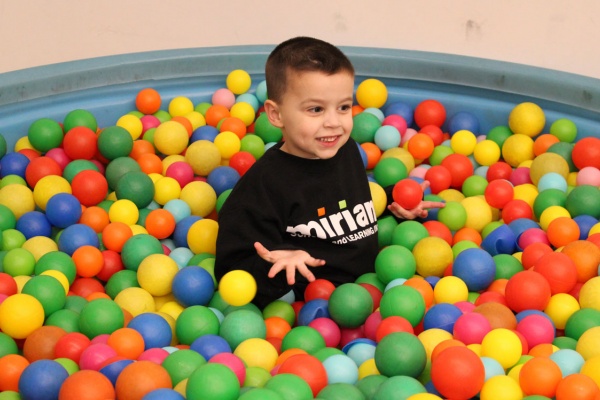
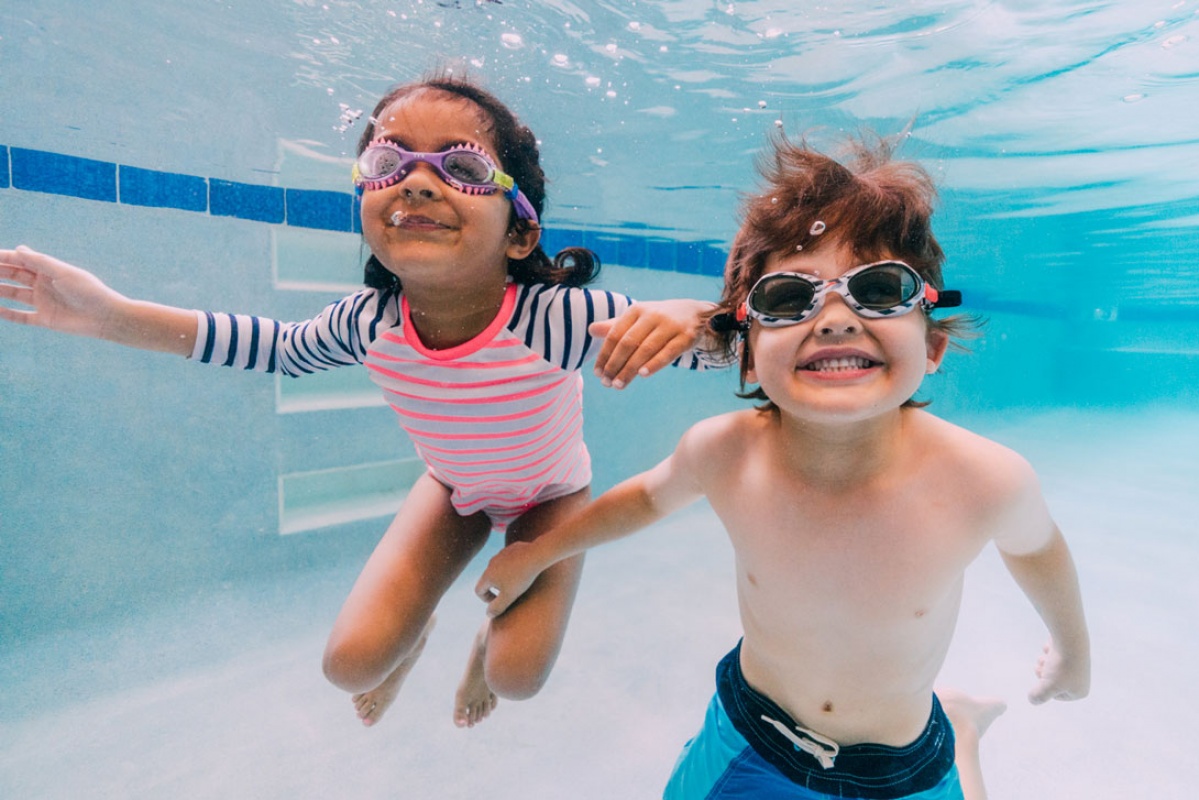
Water Safety Tips for Kids and Parents: Expert Advice From Jon Foss of FOSS Swim School
As parents, we have to ensure someone is watching our kids every time they’re around water. But due to this summer’s nationwide lifeguard shortage, we’ve had to up our game. While lifeguards are never a replacement for caregivers, they’re a reliable second pair of eyes. Now those eyes are watching more swimmers at one time due to understaffing, and at many public swimming areas, there are no longer lifeguards on site.
There are many steps we can take to help safeguard our little ones – having a dedicated “water watcher” who is out of the pool and focused on swimmers instead of their smartphone, putting our kids in brightly-colored swimsuits so they’re easier to spot, and most important, enrolling them in formal swim lessons as soon as possible. According to researchers, when a child between the ages of one to four participates in skills-based programs, their risk of drowning drops by 88%.
When father of five and swim coach Jon Foss co-founded FOSS Swim School 29 years ago, the safety of his students was his highest priority. Today, his age-appropriate, progression-based, and personalized program is taught at 22 FOSS Swim Schools across the Midwest, including locations in Ballwin and O’Fallon, Mo. Two more area schools will be opening soon – St. Charles in the fall and Rock Hill in January 2023.
With the second biggest summer weekend just around the corner this Labor Day, we talked with Foss about how parents can better protect their kiddos in the water and empower them with respect for water safety.
What is the number one thing a parent or caregiver should know about swimming safety?
First and foremost, all parents and caregivers need to understand that "drowning is a silent event." Second, being the ones responsible for their children, parents and caregivers should understand what causes a child to lose air and buoyancy when in the water.
I have seen this mistake countless times during a child’s first full submersion. Here’s the scenario: a child jumps into the water and submerges completely under the water, possibly for the first time in their life, and panics. Then, the child makes the critical mistake of looking up toward the water's surface to yell for help, thus uncorking the natural water/air barrier created by the unique human nose.
Once the child has lost the air in their lungs, they can no longer yell or scream for help. Without the air in their lungs, they’re no longer buoyant and start to sink. This is why drowned children are found on the bottom of a pool.
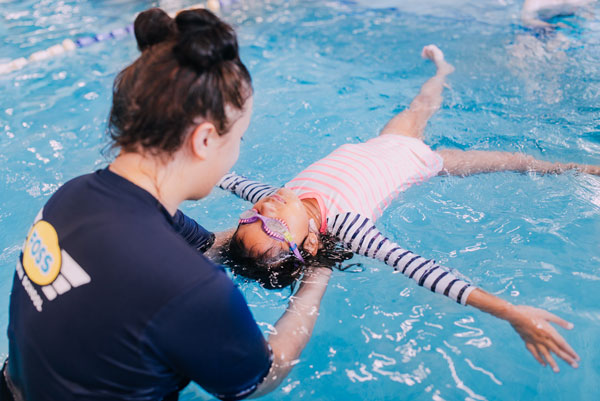
What can good swimming instruction teach a child to do if they find themselves struggling in the water?
First, don't look up! Instead, keep the nostrils facing downward. A swimmer’s eyes should be open as they look back to the wall and swim. Second, when a child needs a breath, they should flip onto their back and breathe before flipping back over and swimming to safety.
Falling into a pool and getting out, again and again, is a mastery of "self-rescue," and it’s a primary skill at FOSS.
Many parents think they have to wait until their child is two or three before they begin swim lessons. Why is it so crucial to start even earlier?
Swimming lessons are one of the few activities toddlers and parents can do together. They should be full of positive memories (little crying) and skin-to-skin contact with their parent as they experience clean, warm water. Classes for children under three are helpful if taught properly – socialization, water adjustment, face underwater, and back-floating can all be learned by age two. Children can learn to float on their back, falling in and getting out, and self-submersion, all before three years old.
What are some important lessons FOSS teaches younger children, and how can we as parents build on them?
Here are some of the simple resilient messages a young child’s brain needs:
I never get into a pool. I only enter on my parent’s cue.
No one will catch me when I fall in. I must go back to the wall by myself.
I know how to catch my breath, swim, and kick with my face in, eyes open.
When I need to breathe, I flip on to my back and float.
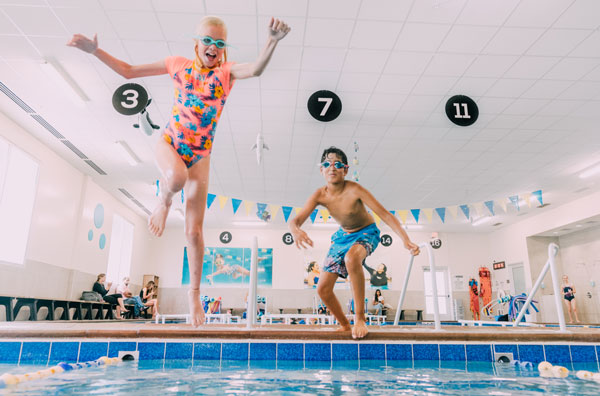
How does FOSS help kids respect the water – to help them find a balance between loving it and fearing it?
FOSS has strict rules about teaching water entry that has helped us teach over 30 million lessons over 29 years without a student drowning. Rules like:
“Never catch a child,”
“Use a ceremony for entering the water, by counting down 3,2,1….”
“Puff the cheeks and look to the wall,”
“Keep the nostrils down,”
“Improper use of strap on floats can lead to false confidence.”
Most children begin life with a natural fear of water – a similar feeling to vertigo. This is good because they have zero skills. The worst thing a program can do is remove the fear faster than it’s replaced with skill.
A child’s ability to swim doesn’t make them drown-proof. So, what should a parent know to help them stay safe?
Even good swimmers can drown if they fall into cold water, deep water, or are dragged down by heavy clothes or a struggling swimmer with superhuman strength. Remember, to put your phone away when your child is in the pool and keep your eyes up.
Finally, understand that it is possible to mislead a child into believing they can swim:
- Being overly reliant on floatation devices
- only swimming in shallow water, and
- always catching your child when they jump in
These are the three primary ways to breed a false sense of security around the water.
What does FOSS do to engage the entire family in learning about swimming safety?
Each quarter, we dedicate a whole week to drowning awareness and water safety. We add drowning-related content, build additional skills into the lessons, have children swim with heavy clothes on, and put up posters to educate families.
For example, swimming with clothes and shoes on is four times harder than swimming in a bathing suit. Swimming with clothes and shoes requires a different method of swimming because the clothes become incredibly heavy, and trying to kick with shoes on is not propulsive.
The “Safety Stroke” is the most effective method of swimming and breathing without bringing the heavy arms and legs out of the water and becomes the focal point of learning for all levels during safety week at FOSS.
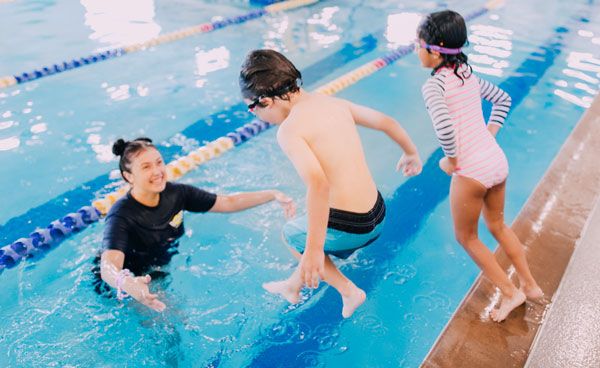
How can swim lessons build a child’s skills and boost their confidence?
I would say that all children can learn to swim because we all appear to be designed to swim. We have an unusual nose, body fat layer, special feet, hands, and neck — the subject is so interesting! But the window of learning to swim well begins to close at age six and is almost entirely gone by age 11.
I encourage all parents to get their child into an active swim program which swims for 25 minutes of each lesson. Then stick with it! Swim teams are great ways for children. Continue until your child can repeatedly swim across a pool using a rhythmic breath. Learning to swim well is an asset for life, and you won’t be disappointed with the investment of your time!
FOSS Swim School is currently accepting enrollments for its weekly classes and Progress Builder Swim Camps this fall. To learn more about its Swim Path program or register your child for lessons, visit fossswimschool.com.
Sponsored by FOSS Swim School. Learn about sponsored content with STL Parent.

Metro East mom Nicole Plegge has written for STL Parent for more than 12 years. Besides working as a freelance writer & public relations specialist, and raising two daughters and a husband, Nicole's greatest achievements are finding her misplaced car keys each day and managing to leave the house in a stain-free shirt. Her biggest regret is never being accepted to the Eastland School for Girls. Follow Nicole on Twitter @STLWriterinIL

















